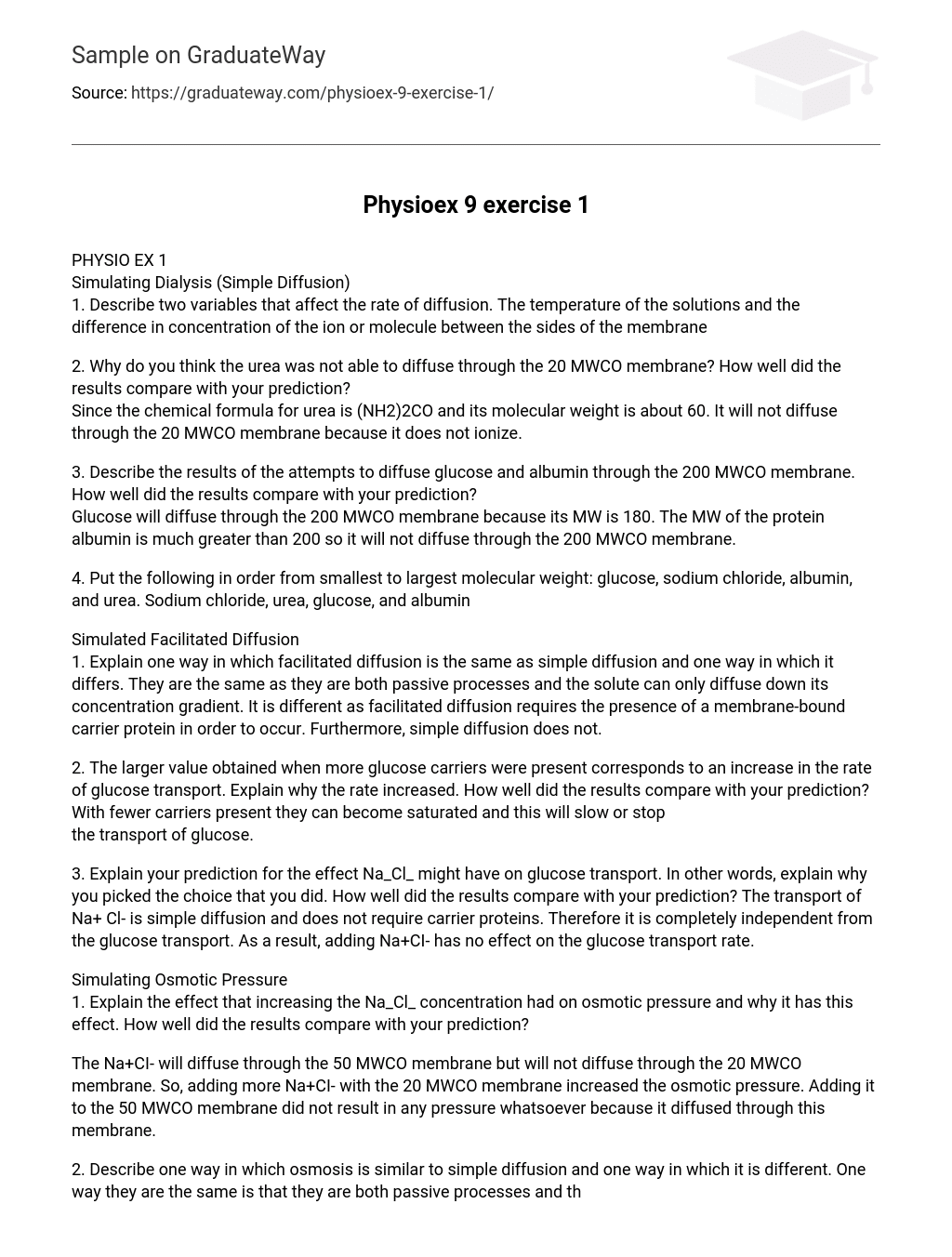PHYSIO EX 1
Simulating Dialysis (Simple Diffusion)
1. Describe two variables that affect the rate of diffusion. The temperature of the solutions and the difference in concentration of the ion or molecule between the sides of the membrane
2. Why do you think the urea was not able to diffuse through the 20 MWCO membrane? How well did the results compare with your prediction?
Since the chemical formula for urea is (NH2)2CO and its molecular weight is about 60. It will not diffuse through the 20 MWCO membrane because it does not ionize.
3. Describe the results of the attempts to diffuse glucose and albumin through the 200 MWCO membrane. How well did the results compare with your prediction?
Glucose will diffuse through the 200 MWCO membrane because its MW is 180. The MW of the protein albumin is much greater than 200 so it will not diffuse through the 200 MWCO membrane.
4. Put the following in order from smallest to largest molecular weight: glucose, sodium chloride, albumin, and urea. Sodium chloride, urea, glucose, and albumin
Simulated Facilitated Diffusion
1. Explain one way in which facilitated diffusion is the same as simple diffusion and one way in which it differs. They are the same as they are both passive processes and the solute can only diffuse down its concentration gradient. It is different as facilitated diffusion requires the presence of a membrane-bound carrier protein in order to occur. Furthermore, simple diffusion does not.
2. The larger value obtained when more glucose carriers were present corresponds to an increase in the rate of glucose transport. Explain why the rate increased. How well did the results compare with your prediction? With fewer carriers present they can become saturated and this will slow or stop
the transport of glucose.
3. Explain your prediction for the effect Na_Cl_ might have on glucose transport. In other words, explain why you picked the choice that you did. How well did the results compare with your prediction? The transport of Na+ Cl- is simple diffusion and does not require carrier proteins. Therefore it is completely independent from the glucose transport. As a result, adding Na+CI- has no effect on the glucose transport rate.
Simulating Osmotic Pressure
1. Explain the effect that increasing the Na_Cl_ concentration had on osmotic pressure and why it has this effect. How well did the results compare with your prediction?
The Na+CI- will diffuse through the 50 MWCO membrane but will not diffuse through the 20 MWCO membrane. So, adding more Na+CI- with the 20 MWCO membrane increased the osmotic pressure. Adding it to the 50 MWCO membrane did not result in any pressure whatsoever because it diffused through this membrane.
2. Describe one way in which osmosis is similar to simple diffusion and one way in which it is different. One way they are the same is that they are both passive processes and the ions or molecules can only pass down their concentration gradients. As far as being different, osmosis is a special form of diffusion, is the diffusion of the solvent through a selectively permeable membrane.
3. Solutes are sometimes measured in milliosmoles. Explain the statement, “Water chases milliosmoles.” Osmosis is the diffusion of the solvent such as water. The water in this simulation diffuses to the side of the membrane that has the highest concentration of the solutes.
4. The conditions were 9 mM albumin in the left beaker and 10 mM glucose in the right beaker with the 200 MWCO membrane in place. Explain the results. How well did the results compare with your prediction? The glucose diffuses from the right beaker to the left beaker until equilibrium is accomplished.
The albumin cannot diffuse through the membrane. An osmotic pressure of 153mmHg results.
Simulating Filtration
1. Explain in your own words why increasing the pore size increased the filtration rate. Use an analogy to support your statement. How well did the results compare with your prediction?
Tea can pass quicker through a plastic filter with a bigger pore size as opposed to a paper filter such as the ones used in coffee makers.
2. Which solute did not appear in the filtrate using any of the membranes? Explain why. Activated charcoal
3. Why did increasing the pressure increase the filtration rate but not the concentration of solutes? How well did the results compare with your prediction?
Increasing the filtration pressure increased the filtration rate. Nonetheless, it did not increase the amount of solute that passed through the filter. Therefore, the concentration was the same.
Simulating Active Transport
1. Describe the significance of using 9 mM sodium chloride inside the cell and 6 mM potassium chloride outside the cell, instead of other concentration ratios.
The 3 Na+ ions are transported out of the cell and 2 K+ ions are transported into the cell. This ratio of 3:2 is the same as the ratio of 9mM:6mM
2. Explain why there was no sodium transport even though ATP was present. How well did the results compare with your prediction?
In order for the Na+/K+ pump to function, both these ions and ATP must be present. In this simulation, no K+ was present.
3. Explain why the addition of glucose carriers had no effect on sodium or potassium transport. How well did the results compare with your prediction?
The addition did not have an effect on the sodium or potassium transport due
to solute pumps.
4. Do you think glucose is being actively transported or transported by facilitated diffusion in this experiment? Explain your answer.
Glucose is being transported down its concentration gradient by facilitated diffusion. The glucose is not actively transported since they are lipid insoluble and too large to pass through the membrane pores.





